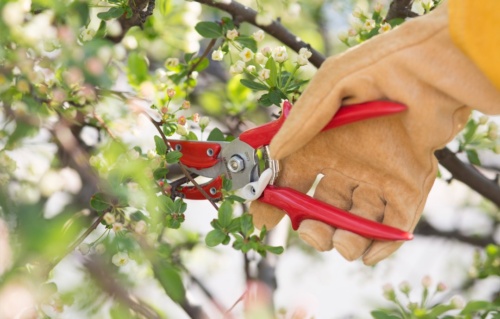A COMPLETE GUIDE ON HOW TO PRUNE A TREE AND SAFETY TIPS.
- June 12, 2023
- Landscapers

tree Pruning is the horticultural activity that involves the targeted removal of specific parts of trees
and plants.
Whether it be a broken or an impoverished tree branch pruning in horticulture involves the
removal of them all. Pruning is a common practice in gardening for the improvement of tree
shape and life. This practice is selective of bad branches, diseased parts of trees and unwanted
portions of it. In pruning, tree branches are cut down so they can grow better in the next season.
In this article you will learn;
● Causes of tree injuries.
● Importance of pruning.
● Types of pruning.
● Benefits of Pruning.
● How to prune a tree.
● When to prune a tree.
● Tools and safety tips for pruning.
CAUSES OF TREE INJURIES
Trees do grow naturally beautiful without pruning them, as exposed to the thin air they are
faced with predators. That is why you need to know how to cater for one.
● ICE: ice on trees makes tree branches makes them 30 times heavy and ultimately leads
to breakage of a branch or a whole tree.
● WIND: the motion of wind on trees, goes down even to the roots, causing them to sway
and this also causes tree breakage.
● DISEASE: over time trees are exposed to degrees of diseases, age can be a factor, also
the environment is not left out.
● FIRE : when tree are exposed to frequent burns, whether natural or man-made. This
takes a toll on their health, leading to diseases and deaths.
● LIGHTNING: lightning from rain and wind storm leaves a breakage effect on the tree.
● RAINFALL: rainfall exposes a tree to excess water, soaking away strength from tree
branches.
● ANIMALS: mice, nematodes, insects, rodents etc.
● ORGANISMS AND PARASITES: viruses, fungi, weeds ,etc.
IMPORTANCE OF PRUNING.
WHY IS PRUNING IMPORTANT? The practice of pruning involves the removal of specific tree branches. Unproductive tree
branches can limit the growth of an entire tree life, removing them opens up airspace for healthy
branches.
A tree growing out of shape can cause an obstruction in a neighborhood, and can begin to
harbor all manner of dangerous things. It is important to know that when pruning a tree, the limbs
are kept intact so as to help the tree remain straight.
TREES ARE PRUNED TO KEEP THEM HEALTHY.
Pruning for tree health involves the removal of unhealthy tree branches.
Bad branches that are still stuck to healthy ones reduces the chance of proper growth.
If left untreated, such damage can cause total death to a tree. By pruning in a specific pattern
you can allow for a good flow of both air and water. During the Pruning process, diseased
branches can be removed, thereby allowing the tree to grow stronger and healthier ones.
TREES ARE PRUNED FOR SAFETY
Safety interest might not be the reason for pruning, but it is worthy of consideration. Dead and
diseased tree and branches poses a potential threat to a family and neighborhood.
Pruning Trees in your yards and gardens sponsors a safe environment for everyone. Dead
branches are potential threat, removing branches that shows signs of weakness is a good place
to start.
Take for example for those who love climbing trees, or maybe a tree that is growing out of
shape stretching towards the road or a neighbor’s yard, electrical lines, blocking traffic views, it’s
a good to prune tree branches that are causing some uneasiness. Trees grown in residential
areas often close to houses, walkways, garages etc. should be pruned regularly to avoid
potential danger.
Trees can grow even up to power lines height, which can become hazardous to the
neighborhood.
TREES ARE PRUNED FOR BEAUTIFICATION
In gardening, pruning gives a beautiful sight to look upon. This provides a serene environment
and beautifies a neighborhood at large.
TO BOOST FRUIT PRODUCTION
When weak branches are pruned out of a tree this provides free flow of nutrients and oxygen
that circulates round the tree.
This will in turn boost growth and fruit bearing.
TYPES OF PRUNING.
There are many gains to pruning your tree or garden, such as keeping them in shape and
good health. Cutting off a branch could make your tree recover from a tree injury and it can also
make them resistant to any potential disease.
Unfortunately most tree owners do not employ the services of tree surgeons until tree limbs are
broken and leads to the death of a tree.
The following are types of tree pruning that could protect the life of a tree.
CROWN THINNING
Crown thinning involves the removal of small and weaker limbs from the top of a tree.
This opens up a tree’s canopy letting free flow of air and lighting to the leaves and branches.
Crown thinning reduces the weight load of large limbs thereby reducing chances of breakage by
strong wind.
DEAD PRUNING
Dead pruning is removing dead, dying and infested tree branches this is essential for the health
of your tree.
Dead pruning also improves the shape and the appearance of your tree or garden. This
provides safety for members of the neighborhood.
CROWN REDUCTION
If the height of your tree is ever a concern to you, then what you need to do is crown reduction.
By removing extra branches crown reduction helps your tree not to get to the mountain top.
For smaller trees mostly crown reduction supports growth and strength without extra added
weight.
CROWN LIFTING
Crown lifting is mostly suitable for growing trees, because crown lifting is carried out on hanging
branches that weighs down the higher ones. This procedure is harmful for larger tree as it can
cause tree injury.
Trees hanging out on roadside and walkways are proper for crown lifting, it also makes tree
grow in matches.
POLLARDING
This is the process of removing all branches and leaving out the skeleton of the secondary
branches. It is done at the growing stage of trees and should be carried out regularly.
RAISING
This is a simple activity of cutting down lower tree branches so they don’t cause intrusion on
buildings.
CLEANING
This is an everyday activity that involves the removal of unwanted plants and dirt’s growing
around the tree.
FORMATIVE PRUNING
It is also known as training, the plant is trained to maintain its shape through this method
MANAGING SIZE
This pruning involves downsizing a tree’s height and width. Branches are cut off and shortened
to fit with utility lines and houses
RESTORA TIVE PRUNING
This is done in overgrown trees, it is usually done in the winter season. Restorative pruning is
when a plant had to be restored.
BENEFITS OF PRUNING
There are several benefits to pruning, some of them includes:
● Quality food products: pruning a tree is the surest way to ensure high quality fruit
production. Pruning tames the heights of trees thereby making harvest simple.
● Provision of sunlight: through pruning plants and trees are exposed to direct sunlight
which is necessary for growth. It allows the plant to thrive by cutting off unwanted
branches.
● Promotes plant health: frequent pruning helps to keep the tree in good health. It
eliminates tree branches infested by pests this promoting healthier growth.
● Sustains growth: pruning sustains the growth process of a tree till maturity and
maintains it at maturity level.
● Provides plant beauty: pruning makes plants to flower that becomes pleasing to the
eyes.
● Plant maintenance: the health of a tree is maintained through regular pruning.
HOW TO PRUNE A TREE
Knowledge on how to prune a tree resources must be sourced for before engaging in the activity. The
following are steps on how to prune a tree.
EXAMINE YOUR TREE: the winter season is a perfect time to inspect your tree, to identify those
branches that needs to be pruned. If the tree branches are longer than two feet they should be
pruned.
IDENTIFY THE RIGHT BRANCH TO REMOVE AND KEEP: the health of a tree is determined
by the branches removed or the ones left.
REMOVE UNWANTED BRANCHES AND LEAVES: take away every sick and dead branches
with a looper or a handsaw.
MAKE CUTS: cuts provides the tree a new shape.
WHEN TO PRUNE A TREE
Arborist and tree surgeons consents that the winter season is the best time for pruning a tree
when the tree is inactive and the leaves are starting to fall.
During the winter season the growth of trees and plants usually slows down.
This is because of some factors responsible;
● Lack of leaves: during the winter season leaves falls off trees, causing proper visibility.
● Absence of pest: pests are unlikely to stay on trees due to lack of leaves.
TOOLS FOR PRUNING TREES
HAND SHEARS
The hand pruners also known as pruning shears or pruners. These are large scissors that cuts
through branches inches thick.
They work just as ordinary hand scissors, the Falco F2 bypass shears are the most commonly
used and they last a lifetime
LOPPERS
The loopers works just as the hand shears but with longer scissors cutting through three inches
deep.
The long scissors helps in trimming high branches, the bypass blades are the most preferred
POLE PRUNERS
The pole pruners are helpful in cutting through two to three inches deep. The average pole
height is about eight feet long.
HAND SAW
Hand saws are mostly used for cutting tree branches up to five inches deep. When
making use of a hand saw, you plant your feet on the ground firmly to avoid been pushed away.
CHAINSAW
For tree branches thicker than five inches, the chainsaw is the perfect match for it
HEDGE SHEARS
Hedge shears are used in cutting hedges.
SAFETY TIPS FOR PRUNING
READ THE MANUAL: with the user manual to every tool, reading them will help in handling
these tools thereby reducing the risk involved.
Safety practices are employed when a manual is read. Every tool has its technicality, the
manual always serves as a guide
WEAR THE CORRECT GEAR:
make sure that every proper gear is worn from top to bottom.
Take off all jewelries. Right from the top: a helmet, safety googles for facial protection,
gloves, boots, thick pants and leg chaps
CHECK THE CONDITIONS
the conditions includes the weather and the surrounding. Some
equipment’s cannot be used in the dark or rainy condition.
The condition must be safe for operation. Be sure of the absence of any obstacle. Also inspect
the condition of the tree you want to prune, dead or dying branches poses a potential threat.
AVOID OVERHEAD CUT:
try as much as possible to avoid cutting a branch above your
head, this could cause injuries.
Tree branches should not be fell over your head even if you are a professional. Do not sit on a
branch you are pruning to avoid falling as a result
KEEP A FIRM FOOT
your feet should be planted to the ground and do not use one hand in
handling a pole saw.
BE TRAINED: you make not use tools you are not trained on how to use, ensure you have
proper training on tools handling and tree climbing
TOOLS MUST BE IN GOOD CONDITION
double checking your tools is essential before
employing a tool for use to avoid casualties. Make sure to properly inspect your tools and
service them if need be
PREPARE FOR EMERGENCY
accidents are not expected, but they are planned for. It is wise
if you lay out plans for emergency, ensure you have safety routes.
HAVE A PARTNER: when climbing a tree, it is best you do so with a partner who is at least 10
feet close by. And do not climb with your tools, allow your partners to hand them over to you
after you must have climbed
SECURE THE PERIMETER
create a security zone of at least 50ft in all directions. Make sure
the area is void of children and pets.
Trees are very important to the ecosystem and our surroundings. They should be treated as
living things as purify the air we breathe and combat climate change.
Trees provides housing for millions of species that protects us from diseases.


